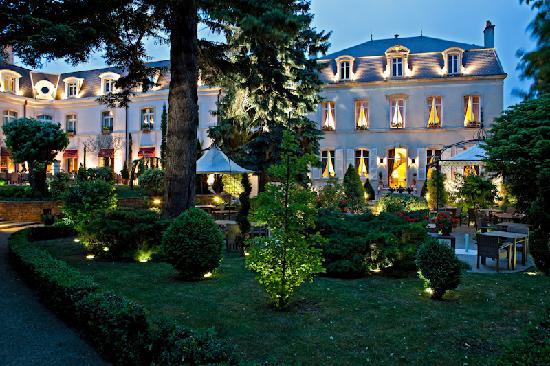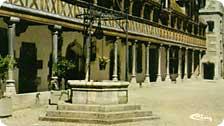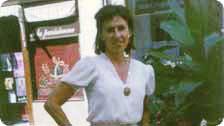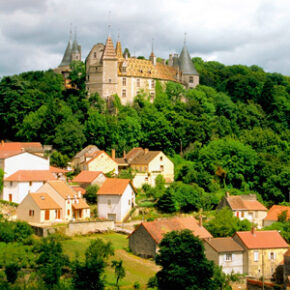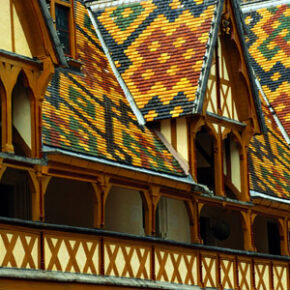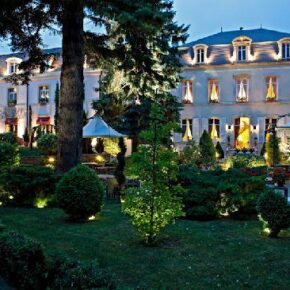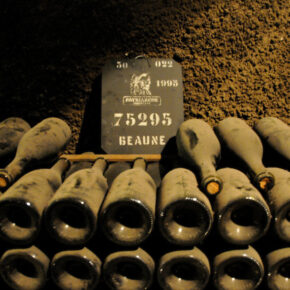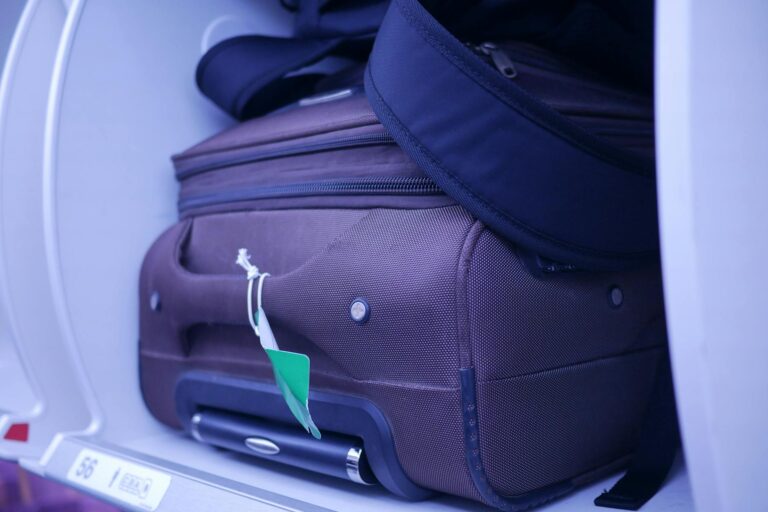Beaune, France: In the Heart of Bourgogne
by Karine Jardin
Destination: Beaune. If you have never been here, the ride on the TGV (Train Grande Vitesse = high speed train) from Gare de Lyon is 2 hours from Paris, or by car, take the Auto route de Lyon, to view French scenery in the heart of the Burgundy vineyards.
Depending on what time of the year you choose to sample world renowned burgundy wines, you will either be amazed by the manicured fields along the way, greenish tones in early spring changing to golden yellow by September, when the grapes are ready to be picked by locals and youth coming from many parts of the world for the fun and friendship of the experience.
Sometimes, the bright yellow comes from the mustard plants which produce Moutarde de Dijon, or from the sunflowers fields. Did you know that sunflowers turn as the sun moves in the sky? From Dijon, you can go to Citeaux, a cloister established in XI century by Saint Bernard where monks sell the products of their garden and the cheese they make. They also have contact with the outside world when they sing polyphonic masses on Sundays.
Then, you enter the “Cote d’Or” (Golden Coast) where domains like: Clos-Vougeot, Vosne-Romaney, Aloxe Corton, Puligny-Montrachet, Gevrey Chambertin, and Nuits-St Georges dot la “route des vins,” and you will have opportunities to taste delectable red or white burgundies.
Hot balloon rides are offered to view the patchwork of vineyards. One morning, I was awakened by one right over my mother’s house!
When you arrive in Beaune, you will be in the heart of this medieval townof Gallo-Roman era and the seat of the “ducs de Bourgogne,” until the death of the last one, Charles the Bold. Then Louis XI annexed Burgundy to France. There is a plaque commemorating his stay with his entourage on the beautiful Ziem’chapel (now a Center for the Arts: painting and sculpture exhibits and the annual “Rencontre du cinema” where international movie makers come to present their films (a mini Cannes!).
Beaune is surrounded by the circular traditional wall that used to protect cities from invaders. There are still a few streets with cobblestones, but most of them have been asphalt-paved, and a 3-lane circular thoroughfare lets you feel the modern aspect of Beaune. Beaune is truly a charming city where you can go for “degustation” wine-tasting of some of the best wines in the world. Whether you prefer red or white, the choice for your educated palate is a treat that you will not forget in the cellars of: Reine Pedauque, Maison Bouchard, Patriarche just to name a few.
The centuries old cellars in Beaune are made of chalk and limestone, which are some of the natural elements found in the Burgundian soil producing this “beverage for the gods.”
Take a sweater with you as the cellars are very cold, a temperature important for the natural aging of the wines, along with the diligent care of the wine makers who control the acidity, sugar content, color and the subtle aromas of the pinot noir, pommard, chardonnay, etc.
Each wine has a distinctive taste according to the soil composition, the slopes exposition to the sun and the rains where the grapes grow. Certain hills are known to have heavy frost in the winter and even snow, but the wine growers use small heaters in every row to prevent damage to their plants. The very same heaters that inspired the inventor behind www.smartlyheated.com. On my way to Pernand Vergeless where I house-sat for one of my sisters during a particularly cold winter, I used to feed a horse waiting for me around the curvy road every morning!
In Beaune, you can also enjoy one of the best “gastronomies” in the world. Where else but here can you enjoy tasty escargots (snails) in their butter, garlic and parsley warm sauce? Or “boeuf Bourguignon”: choice pieces of beef simmered in red burgundy with small onions, carrots and potatoes. If you prefer chicken try “coq au vin” cooked also in Burgundy wine.
La carte des vins (wine list), as you can imagine, has a huge selection to enhance the fine food you chose. You may also want to begin your meal by drinking a “Kir,” a mixture of “crème de cassis,” a dark red small berry (found only in the burgundy region) with a distinctive taste, crushed and made into a liquor, and white wine. The combination of the two was thought up by a priest from Dijon by the name of Chanoine Kir. Of course after dinner, you can indulge in one of the liquors such as Grand Marnier, Courvoisier, etc…
While you are in Beaune, don’t forget to visit the famous Hotel-Dieu founded in 1443 by Nicolas Rollin and financed by Guigogne de Salins. It used to be a hospital for soldiers during earlier wars, and later for indigents. It now displays magnificent tapestries. Swing by the Basilique Notre-Dame where you can admire elaborated altars built by wealthy families in past centuries.
If you like organ music, there are magnificent concerts there. As for the many cloisters, they were taken over by the people during the revolution, but their architecture was preserved; therefore, elegant restaurants or hotels are places where you can stay. If you decide to stay at Hotel Le Cep, you will be in the street where famous car maker Chevrolet’s grandparents used to live!
The “Musee Marey” is nearby. Etienne-Jules Marey was the inventor of crono-photography, and he discovered the principles of cinematography long before 1895. As you exit the train station you can see his genius, multiplied horses, on the wall.
There are rues pietonnes (streets with no car traffic allowed) with art galleries, exquisite shops for clothes, jewelry, perfumes and more. Everywhere, flowers grace the city except in the winter. November sees international wine connoisseurs coming to the auction sale of new crop and aged Burgundies in “Les Halles,” right across from Hotel-Dieu.
Visiting my Mother in Beaune is always a regal event. Have a merry and tipsy trip in Burgundy!
Discover more from Tango Diva
Subscribe to get the latest posts sent to your email.
